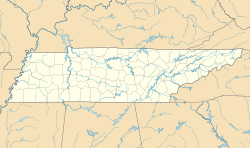Church House (Columbia, Tennessee) facts for kids
Quick facts for kids |
|
|
Church House
|
|

The Church House in 2013
|
|
| Location | 312 W. 7th St., Columbia, Tennessee |
|---|---|
| Area | 0.6 acres (0.24 ha) |
| Built | 1873 |
| Architectural style | Second Empire |
| NRHP reference No. | 78002609 |
| Added to NRHP | October 19, 1978 |
Church House, also known as the Barrow House, is a historic mansion in Columbia, Tennessee. It was built around 1873 and is a great example of the Second Empire architectural style. This grand house was added to the National Register of Historic Places in 1978, recognizing its special historical and architectural importance.
The Church House is a large, impressive brick house. It has a unique, block-like shape and lots of fancy decorations. It is three stories tall and sits on a strong stone foundation.
A special feature is its mansard roof, which is covered with decorative slate shingles. This type of roof is very common in Second Empire style buildings. The front of the house (south side) has a tower that sticks out. This tower is another classic part of the Second Empire design. The main entrance has a fancy, rounded arch.
You will also see bay windows on the sides, which are windows that stick out from the wall. They have round-headed windows, and some even have decorative tops. Even though the back of the house has been changed a bit for a kitchen, the front still looks just like it did when it was built. The house is located in an old, fancy neighborhood in Columbia, where many large historic homes still stand.
History of the Church House
The Barrow House was reportedly built by Maury County Sheriff Latta around 1873. In 1885, Robert Church, who was a banker and land investor, bought the house. The Church family, including Robert and his descendants, lived in this house for about 100 years.
Later, Robert Church's grandson, Robert Church Barrow, inherited the house.
Who Designed the House?
The architect for Sheriff Latta's new home was a man named Mr. Williamson from Nashville. His full name was Peter J. Williamson. This information was found in The Columbia Daily Herald newspaper, printed on November 7, 1873.



